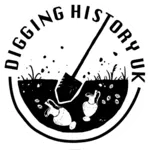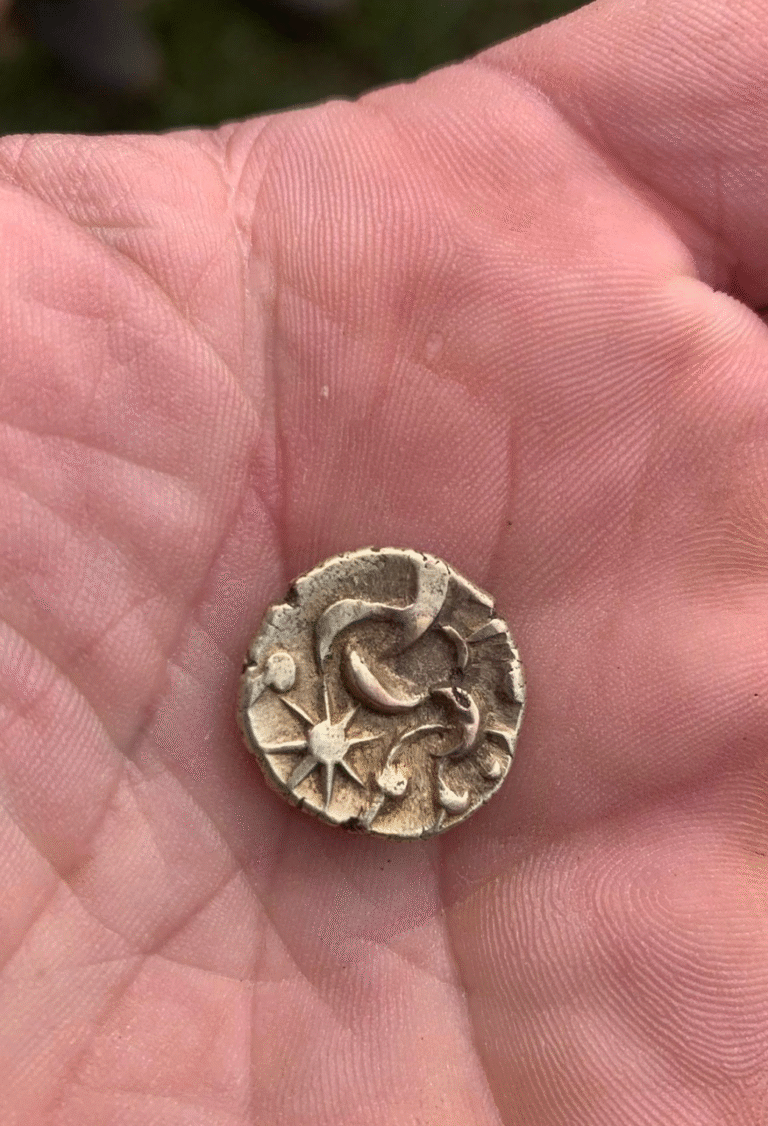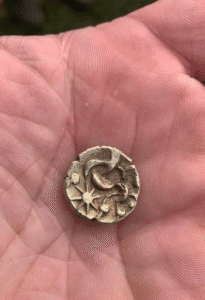From Iron Age Gold to Stuart Silver – A Day of Rich Finds at Helpston
On Thursday 11th September, detectorists gathered at Helpston, a village best known as the birthplace of poet John Clare but whose history stretches back far beyond the 19th century. Beneath the rolling fields, the soil yielded treasures spanning two millennia – from Celtic gold staters and Roman brooches to hammered silver and Georgian buttons. As one detectorist put it, it was a “SUPER SUPER DAY!”
Roman Craftsmanship
The morning got off to a strong start with Sandra Ball unearthing a fine Roman fibula brooch. These small but significant artefacts once fastened Roman cloaks and tunics, a reminder of how everyday objects survive the centuries to tell us stories of fashion, trade, and settlement.
“Nice little fibula, well done Sandra.” – Simon Toomer
Such finds mark the Roman presence in the East Midlands, when roads, villas, and farmland transformed the local landscape.
Celtic Gold and Iron Age Tribes
The showstopper of the day came when John Barley discovered a stunning Celtic gold stater, its design of crescents and stars gleaming in the sun. These coins, struck by Iron Age tribes before the Roman conquest, were both currency and symbols of power.
“Well done John … I bet you’re buzzing finding that, it’s beautiful.” – Maxine Stewart Bett
The find links Helpston directly to the tribal communities of over 2,000 years ago, when gold coins like this would have circulated among warriors, chieftains, and traders.
Medieval Silver and the Noble
Silver soon followed. Southlincs Searcher proudly shared a gleaming quarter noble, a medieval gold coin first issued under Edward III. Although only a fragment, it carried the prestige of England’s growing economy in the 14th century, when such coins crossed Europe in the hands of merchants and pilgrims.
Other hammered finds included a James I halfgroat, as well as groats and pennies from medieval reigns — each coin a voice from the marketplace, tavern, or roadside inn where it once changed hands.
Finds from Many Centuries
The field offered up a kaleidoscope of artefacts from different eras:
Ben Lamb displayed a mixed selection of hammered silver, buckles, and copper coins.
Gavin Healey, on his first dig with the group, proudly showed a spread of hammered coins, Georgian coins, and lead musket balls.
Sandra Ball added a curious piece featuring a Roman-style head, alongside thimbles and hammered silver.
Fiona Gurney enjoyed a “little and large” moment with buttons and a fine silver coin.
Justin Maskell closed the day with a spread including a decorated mount, half a hammered, and Georgian coinage.
Gintaras Beimavicius summed it up best with a smile and the words: “SUPER SUPER DAY!”
Helpston’s Historical Landscape
Helpston is more than a village of poets and farmland. The land sits within a rich archaeological zone:
Iron Age tribes once struck gold staters that circulated across Britain.
Romans left brooches, pottery, and coins as they farmed and traded.
Medieval villagers spent hammered silver and gold nobles in everyday life.
Post-medieval finds like thimbles, musket balls, and Georgian buttons remind us of centuries of domestic life, wars, and rural work.
Today, detectorists walk the same fields, reviving these stories from the soil and adding new chapters to Helpston’s long history.
Fellowship in the Field
Beyond the glitter of gold and silver, the day was about camaraderie. Detectorists swapped stories, admired each other’s finds, and shared laughs in the September sunshine. From ancient fibulae to medieval nobles, every item was a window into the lives of those who came before. And as always, the joy was in discovering together.












